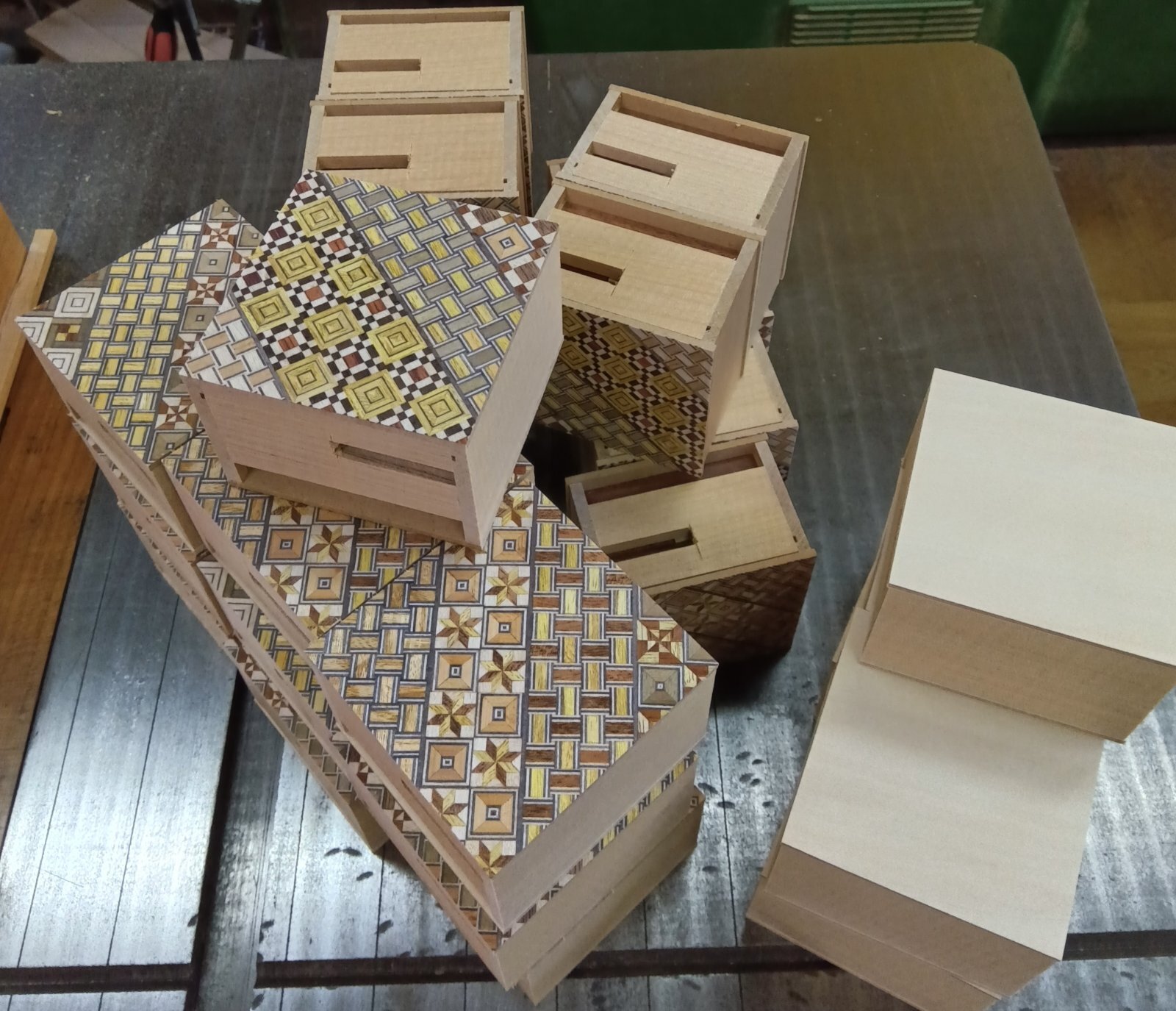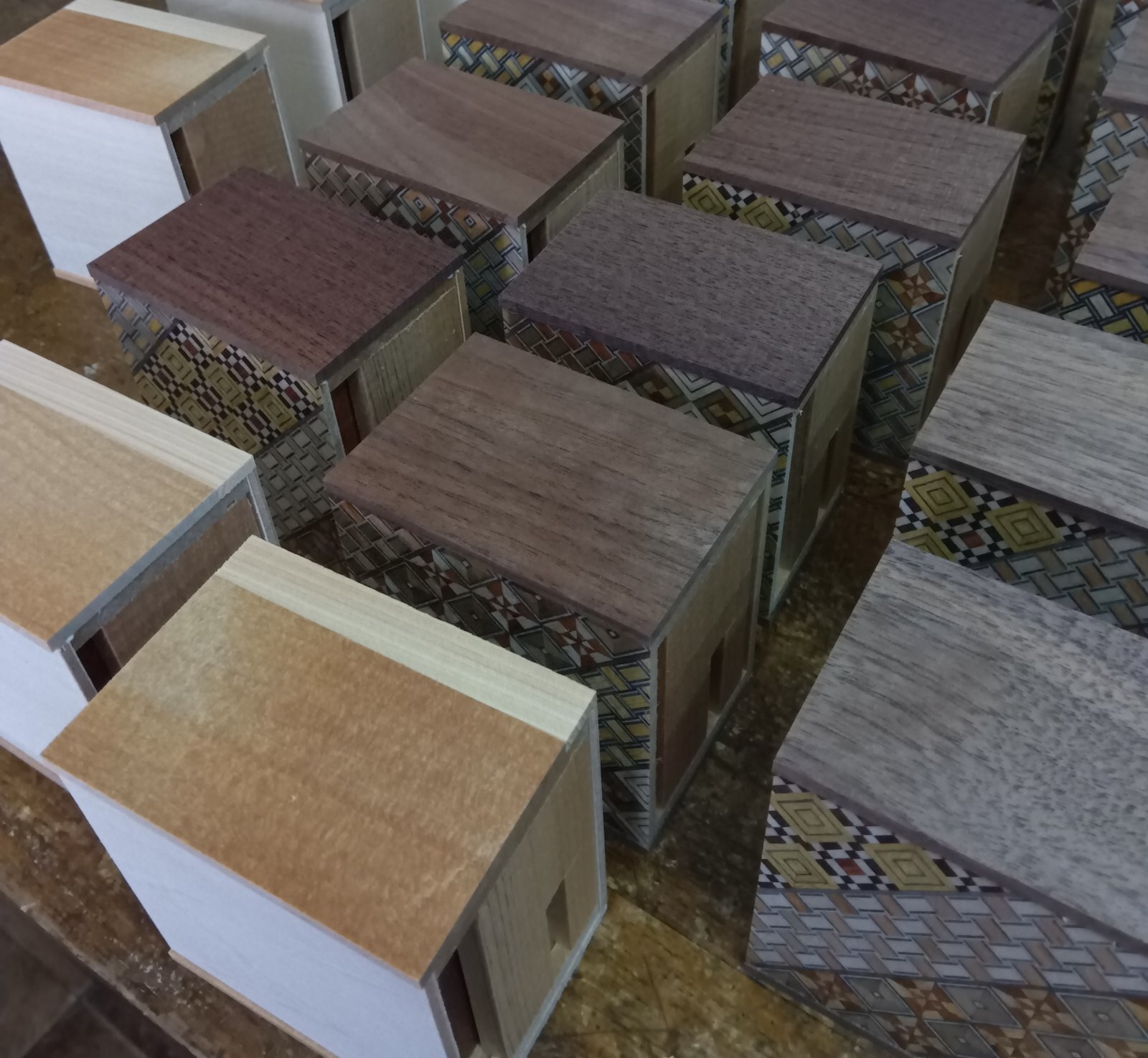Square box
I'm currently working on a 4-sun 27-step Himitsu-bako and simultaneously creating the square design Himitsu-bako with a 12-step mechanism. I'm making a small number of boxes for delivery to one store (yosegi/walnut wood design), with five extras where I plan to add some unique designs. These designs will feature printed characters, such as "kanji", which I've made several times before. I haven't decided which characters to use yet, but the design will be applied just before the finishing coating, so there's still some time. However, since the finishing is scheduled for tomorrow, I need to decide soon😅
I started making the square design box about six years ago. This box has the same specifications as the 4-sun size box, meaning the height, width, and all the internal parts are identical. The only difference is the length, which has been shortened to match the width, so when viewed from above, the box is a perfect square.
The mechanism for this box is usually a 12-step mechanism, though I have also made a 14-step version. I haven't created a mechanism with more moves for this box yet, and I currently have no plans to do so. I’m thinking of making many of these boxes with unique designs, such as a kanji series or a solid wood series. This time, I plan to use kanji designs again.
When I make this box, I can follow the same process as with a 4-sun box, but one issue is that the upper Aruki (moving panel) is shorter. Since this box is shorter in length compared to a 4-sun box, the length of the aruki is also shorter. For reference, the structure length of the 4-sun box is about 11 cm, while this square box is 7.5 cm. Usually, I make the upper aruki (the structural panel under the lid panel) a bit loose for two reasons: first, because the longer length tends to cause more friction, making the movement tight, and second, because it is harder to move since the panel is pushed from the top. Unlike the side aruki, the upper aruki cannot be pushed from the end of the panel. Instead, it has to be pressed down from the top to move. If the movement is too tight, it becomes difficult to operate.
However, if I make the aruki loose in the square box, it becomes too loose. The main reason is that there are fewer contact points to generate friction, so it tends to loosen up. Additionally, since the moving distance of top panel's aruki is shorter, the aruki can easily fall out when the puzzle box is opened. Therefore, when making the square box, I finish the upper aruki panel a bit tighter than usual. Aside from this adjustment, the rest of the process is the same as making a 4-sun box.
I started making the square design box about six years ago. This box has the same specifications as the 4-sun size box, meaning the height, width, and all the internal parts are identical. The only difference is the length, which has been shortened to match the width, so when viewed from above, the box is a perfect square.
The mechanism for this box is usually a 12-step mechanism, though I have also made a 14-step version. I haven't created a mechanism with more moves for this box yet, and I currently have no plans to do so. I’m thinking of making many of these boxes with unique designs, such as a kanji series or a solid wood series. This time, I plan to use kanji designs again.
When I make this box, I can follow the same process as with a 4-sun box, but one issue is that the upper Aruki (moving panel) is shorter. Since this box is shorter in length compared to a 4-sun box, the length of the aruki is also shorter. For reference, the structure length of the 4-sun box is about 11 cm, while this square box is 7.5 cm. Usually, I make the upper aruki (the structural panel under the lid panel) a bit loose for two reasons: first, because the longer length tends to cause more friction, making the movement tight, and second, because it is harder to move since the panel is pushed from the top. Unlike the side aruki, the upper aruki cannot be pushed from the end of the panel. Instead, it has to be pressed down from the top to move. If the movement is too tight, it becomes difficult to operate.
However, if I make the aruki loose in the square box, it becomes too loose. The main reason is that there are fewer contact points to generate friction, so it tends to loosen up. Additionally, since the moving distance of top panel's aruki is shorter, the aruki can easily fall out when the puzzle box is opened. Therefore, when making the square box, I finish the upper aruki panel a bit tighter than usual. Aside from this adjustment, the rest of the process is the same as making a 4-sun box.

